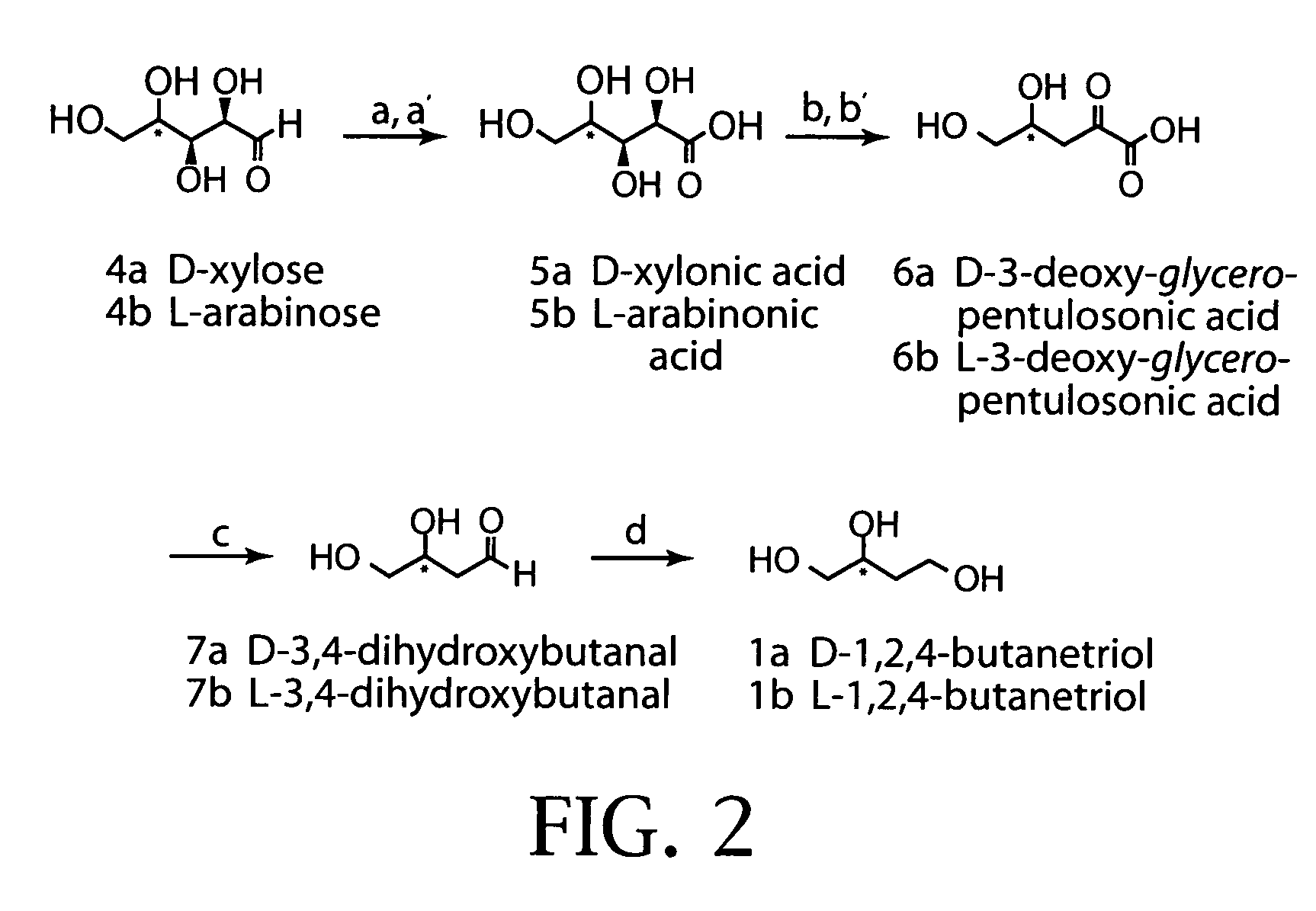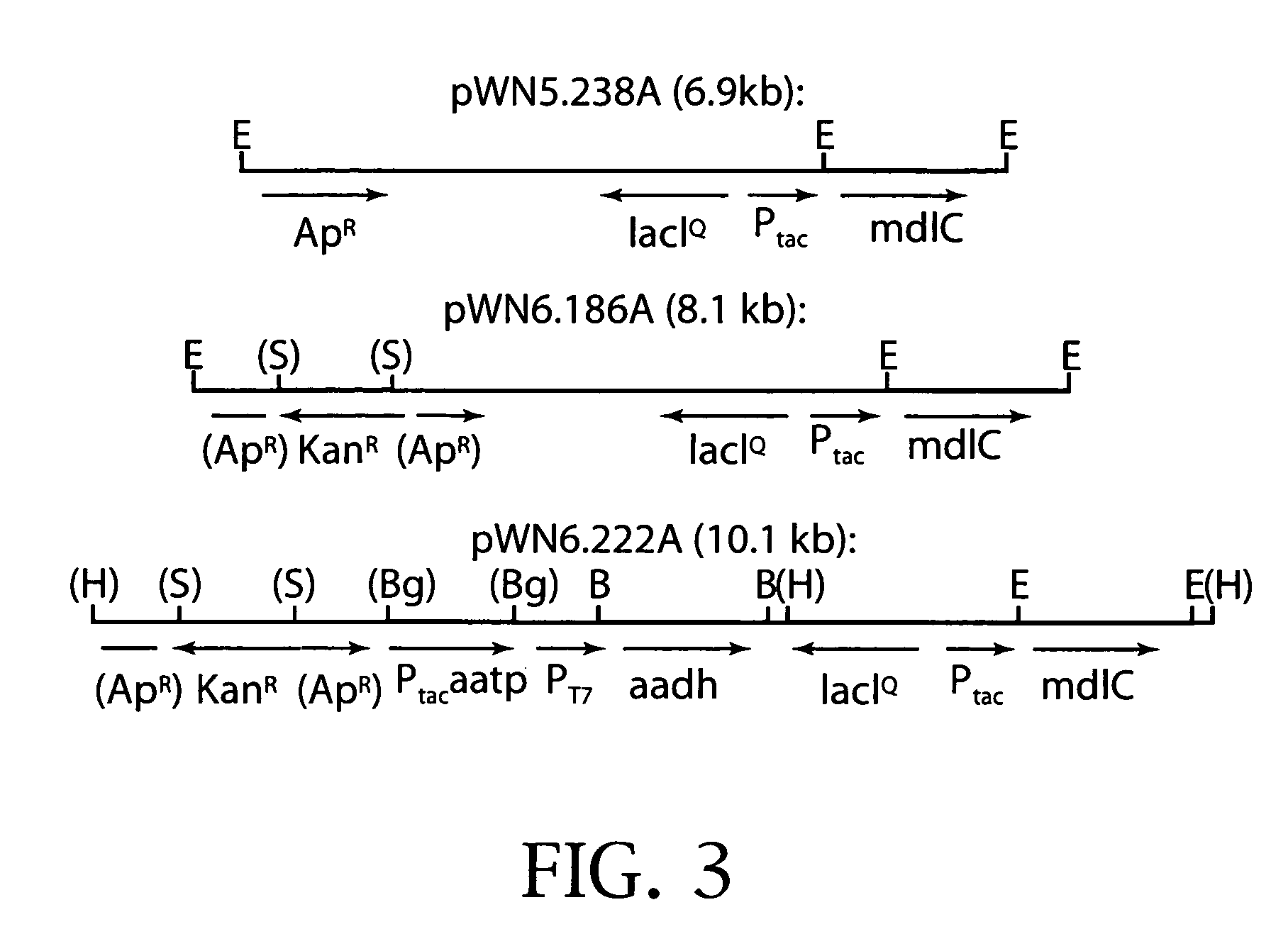Synthesis of 1,2,4-butanetriol enantiomers from carbohydrates
a technology of 1,2,4-butanetriol and enantiomers, which is applied in the field of synthesis of 1,2,4-butanetriol enantiomers from carbohydrates, can solve the problems of limited availability of 1,2,4-butanetriol starting materials, low yield, and general impracticality for large-scale use of current substitutes for high-pressure catalytic hydrogenation of d,l-malic acid used to obtain butanetriol, etc., and achieves good
- Summary
- Abstract
- Description
- Claims
- Application Information
AI Technical Summary
Benefits of technology
Problems solved by technology
Method used
Image
Examples
example 1
[0190]Fermentor-controlled cultivation (1 L) of E. coli DH5α / pWN6.186A at ambient pressures and 33° C. resulted in the conversion of D-xylonic acid (10 g / L) into D-1,2,4-butanetriol (1.6 g / L) in 25% yield. Similar cultivation of E. coli BL21(DE3) / pWN6.222A leads to the conversion of L-arabinonic acid (10 g / L) into L-1,2,4-butanetriol (2.4 g / L) in 35% yield. Stereochemical assignments for microbe-synthesized produces are based on the conversion to Mosher esters and comparison with similarly derivatized D- and L-1,2,4-butanetriol obtained from commercial sources. (Dale, J. A.; Mosher, H. S. J. Am. Chem. Soc. 1973, 95, 51.2.) E. coli DH5α / pWN6.186A synthesized ethylene glycol (0.093 g / L) for a 3% yield of this byproduct, while E. coli BL21(DE3) / pWN6.222A synthesized ethylene glycol (0.087 g / L) in 2% yield.
example 2
[0191]Microbial synthesis begins with pentose oxidation using fermentor-controlled cultures (e.g., 1 L scale) of Pseudomonas fragi ATCC4973. (Buchert, J.; Viikari, L.; Linko, M.; Markkanen, P. Biotechnol. Lett. 1986, 8, 541. and Weimberg, R. J. Bio. Chem. 1961, 236, 629). D-xylose (100 g / L) is oxidized at 30° C. to D-xylonic acid and produces a 70% yield (77 g / L). L-arabinose is similarly oxidized and produces a 54% overall yield to a mixture of L-arabino-1,4-lactone (40 g / L) and L-arabinonic acid (15 g / L). The lactone is subsequently hydrolyzed to L-arabinonic acid. Escherichia coli constructs are then employed for the conversion of D-xylonic acid and L-arabinonic acid into the respective enantiomers of 1,2,4-butanetriol.
PUM
| Property | Measurement | Unit |
|---|---|---|
| temperature | aaaaa | aaaaa |
| temperature | aaaaa | aaaaa |
| temperature | aaaaa | aaaaa |
Abstract
Description
Claims
Application Information
 Login to View More
Login to View More - R&D
- Intellectual Property
- Life Sciences
- Materials
- Tech Scout
- Unparalleled Data Quality
- Higher Quality Content
- 60% Fewer Hallucinations
Browse by: Latest US Patents, China's latest patents, Technical Efficacy Thesaurus, Application Domain, Technology Topic, Popular Technical Reports.
© 2025 PatSnap. All rights reserved.Legal|Privacy policy|Modern Slavery Act Transparency Statement|Sitemap|About US| Contact US: help@patsnap.com



